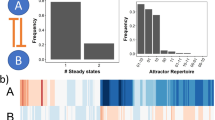Abstract
The concept of robustness of regulatory networks has been closely related to the nature of the interactions among genes, and the capability of pattern maintenance or reproducibility. Defining this robustness property is a challenging task, but mathematical models have often associated it to the volume of the space of admissible parameters. Not only the volume of the space but also its topology and geometry contain information on essential aspects of the network, including feasible pathways, switching between two parallel pathways or distinct/disconnected active regions of parameters. A method is presented here to characterize the space of admissible parameters, by writing it as a semi-algebraic set, and then theoretically analyzing its topology and geometry, as well as volume. This method provides a more objective and complete measure of the robustness of a developmental module. As a detailed case study, the segment polarity gene network is analyzed.
Similar content being viewed by others
References
Alon U, Surette MG, Barkai N, Leibler S (1999) Robustness in bacterial chemotaxis. Nature 397: 168–171
Little JW, Shepley DP (1999) Robustness of a gene regulatory circuit. EMBO J 18: 4299–4307
von Dassow G, Meir E, Munro EM, Odell GM (2000) The segment polarity network is a robust developmental module. Nature 406: 188–192
Kim J, Bates DG, Postlethwaite I, Ma L, Iglesias P (2006) Robustness analysis of biochemical network models. IEE Proc Syst Biol 153: 96–104
Savageau MA (1971) Parameter sensitivity as a criterion for evaluating and comparing the performance of biochemical systems. Nature 229: 542–544
Heinrich R, Schuster S (1996) The regulation of cellular systems. Chapman & Hall, New York
Sanson B (2001) Generating patterns from fields of cells. Examples from Drosophila segmentation. EMBO Rep 21: 1083–1088
Ingolia NT (2004) Topology and robustness in the Drosophila segment polarity network. PLoS Biol 2: 0805–0815
Albert R, Othmer HG (2003) The topology of the regulatory interactions predicts the expression pattern of the Drosophila segment polarity genes. J Theor Biol 223: 1–18
Umulis D, O’Connor MB, Othmer H (2007) Robustness of embryonic spatial patterning in Drosophila melanogaster. Curr Top Dev Biol 81: 65–111
Chaves M, Albert R, Sontag ED (2005) Robustness and fragility of boolean models for genetic regulatory networks. J Theor Biol 235: 431–449
Chaves M, Sontag ED, Albert R (2006) Methods of robustness analysis for boolean models of gene control networks. IEE Proc Syst Biol 153: 154–167
Ma W, Lai L, Ouyang Q, Tang C (2006) Robustness and modular design of the drosophila segment polarity network. Mol Syst Biol 2: 70
Gutenkunst RN, Waterfall JJ, Casey FP, Brown KS, Myers CR, Sethna JP (2007) Universally sloppy parameter sensitivities in systems biology models. PLoS Comput Biol 3(10): e189+
Dayarian A, Chaves M, Sengupta A, Sontag ED (2008) Shape, size and robustness: feasible regions in the parameter space of biochemical networks. PLoS Comput Biol (in press)
Sengupta AM, Djordjevic M, Shraiman BI (2002) Specificity and robustness in transcription control network. Proc Natl Acad Sci USA 99: 2072–2077
Hooper JE, Scott MP (1992) The molecular genetic basis of positional information in insect segments. In: Hennig W (eds) Early embryonic development of animals. Springer, Berlin, pp 1–49
Hidalgo A, Ingham PW (1990) Cell patterning in the Drosophila segment: spatial regulation of the segment polarity gene patched. Development 110: 291–301
Eaton S, Kornberg TB (1990) Repression of ci-d in posterior compartments of drosophila by engrailed. Genes Dev 4: 1068–1077
von Dassow G, Odell GM (2002) Design and constraints of the drosophila segment polarity modude: robust spatial patterning emerges from intertwined cell state switches. J Exp Zool (Mol Dev Evol) 294: 179–215
Swantek D, Gergen JP (2004) Ftz modulates runt-dependent activation and repression of segment -polarity gene transcription. Development 131: 2281–2290
Collins GE (1975) Quantifier elimination for real closed fields by cylindrical algebraic decomposition. In: Second GI Conference on Automata Theory and Formal Languages, Kaiserslauten. Lecture Notes Comp. Sci., vol 33 Springer, Heidelberg, pp 134–183
Arnon DS, Collins GE, McCallum S (1984) Cylindrical algebraic decomposition I: the basic algorithm. SIAM J Comput 13: 865–877
Brown C, Hong, et al. H QEPAD. http://www.cs.usna.edu/qepcad/B/QEPCAD.html
Collins GE, Hong H (1991) Partial cylindrical algebraic decomposition in quantifier elimination. J Symb Comput 12: 299–328
Wolfram S (1998) The Mathematica Book, 4th edn. Wolfram Media, Cambridge University Press, London
Nešić D, Mareels IMY, Glad ST, Jirstrand M (2001) Software for control system analysis and design, symbol manipulation. In: Webster J (eds) Encyclopedia of electrical and electronics engineering. Wiley, London
Lafferriere G, Pappas G, Yovine S (2001) Symbolic reachability computation for families of linear vector fields. J Symb Comput 32: 231–253
Ghosh R, Tomlin CJ (2004) Symbolic reachable set computation of piecewise affine hybrid automata and its application to biological modeling: Delta-notch protein signaling. IEE Trans Syst Biol 1: 170–183
Author information
Authors and Affiliations
Corresponding author
Rights and permissions
About this article
Cite this article
Chaves, M., Sengupta, A. & Sontag, E.D. Geometry and topology of parameter space: investigating measures of robustness in regulatory networks. J. Math. Biol. 59, 315–358 (2009). https://doi.org/10.1007/s00285-008-0230-y
Received:
Revised:
Published:
Issue Date:
DOI: https://doi.org/10.1007/s00285-008-0230-y




